This sourdough cornbread is soft, tender, and golden with just the right amount of sweetness. It is the ultimate way to use up your fresh sourdough discard. This cornbread recipe is egg-free and so forgiving that it is going to be your new favorite!
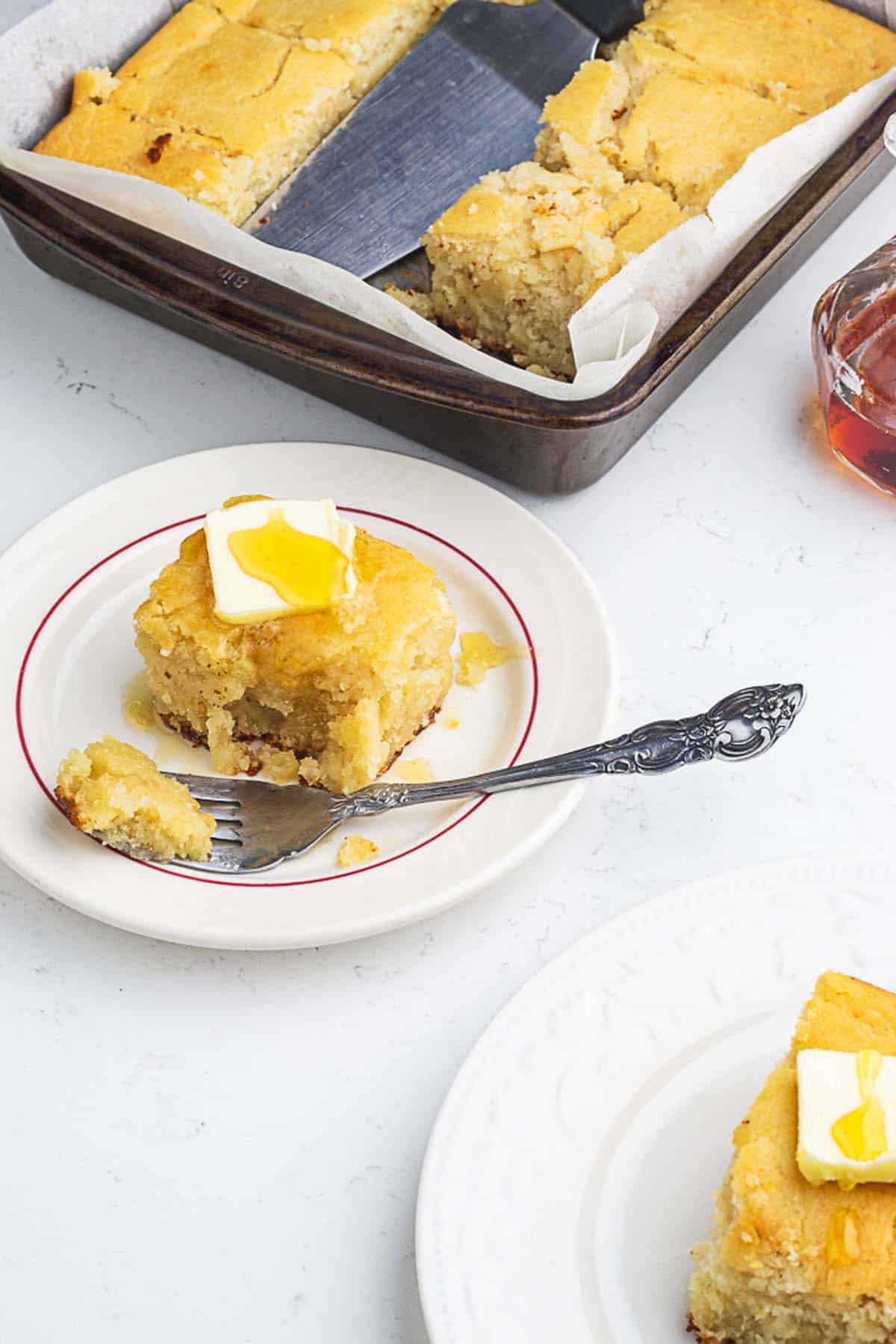
Jump to:
👩🏽🍳 Why You’ll Love This Egg-Free Sourdough Cornbread
- No eggs needed – Perfect for vegetarians or when you're simply out of eggs.
- A great way to use sourdough discard—a practical twist on classic cornbread recipes.
- Can be made using either a bubbly active sourdough starter or fresh discard.
- Ready in under 30 minutes of baking, perfect for weeknights.
- Pairs beautifully with butter and honey, or makes a cozy base for cornbread, sourdough stuffing.
🧂Ingredient Notes with Substitutes and Tips
Here’s a breakdown of what goes into this sourdough discard cornbread—and how you can adapt it to your pantry:
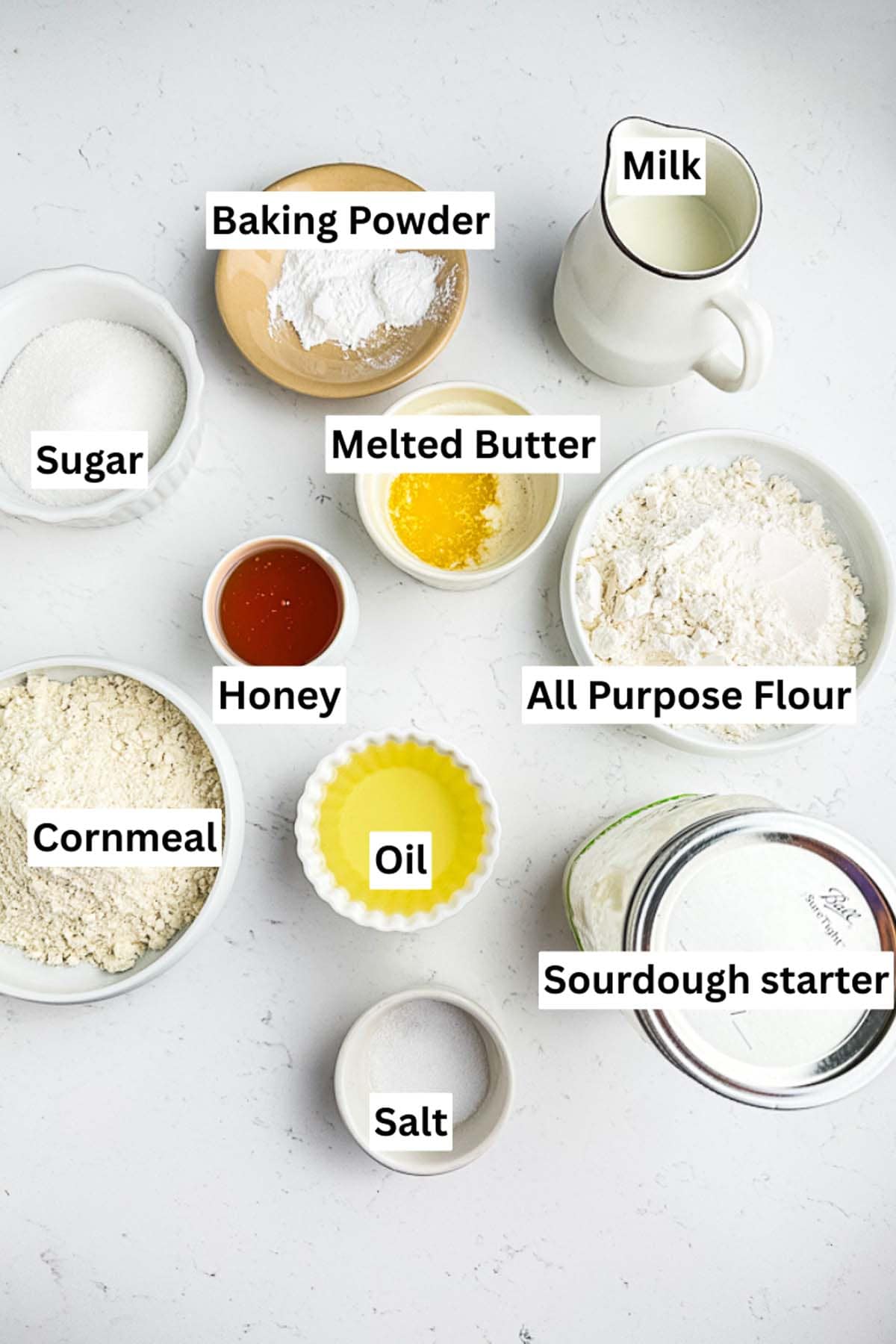
- Cornmeal
Use medium or fine-grind yellow cornmeal for classic texture. Avoid self-rising cornmeal—this recipe already has baking powder and baking soda measured in. Organic or stone-ground cornmeal adds extra flavor and texture. - All-Purpose Flour
This balances the crumb and prevents the cornbread from being overly grainy. You could swap in white whole wheat flour for added nutrition, but the texture will be slightly denser. Perfect if you're looking for corn flour bread recipes with a healthier twist. - Sugar & Honey
This combo gives the cornbread batter just the right touch of sweetness. You can reduce sugar or use maple syrup if preferred. Pro tip: grease your spoon before measuring honey so it slides right off! - Unsalted Butter
Melted unsalted butter adds richness and depth. Vegan? Use coconut oil or a neutral oil like avocado or grapeseed. - Whole Milk
Use room-temperature whole milk for best texture. For vegan sourdough cornbread, use oat or almond milk. Avoid skim—it’ll result in a dry bake. - Neutral Oil
Adds moisture without overpowering flavor. A must for achieving that classic tender crumb found in Jiffy sourdough cornbread copycats. - Baking Powder
It ensures a fluffy rise, even without eggs. Make sure your baking powder is fresh! - Sourdough Starter or Discard
You can use either a bubbly active sourdough starter or fresh discard from your fridge. You can even use 1-2 day old discard also, just before it becomes more sour. This recipe is part of the best recipes sourdough discard lovers need!
🔪Step-by-Step Instructions
Step 1: Mix Wet Ingredients and Soak the Cornmeal
In a large mixing bowl, add the following wet ingredients: Sourdough discard or active starter (at room temperature), whole milk, melted unsalted butter (make sure it has cooled slightly), neutral oil (like avocado or sunflower oil), and honey.
Whisk the mixture thoroughly until everything is well blended and smooth. It should have a creamy consistency with a mild, tangy aroma from the sourdough starter.
Next, add the cornmeal to the bowl. Stir until fully incorporated. The batter will look slightly coarse and loose at this point—don’t worry! This step is crucial because it allows the cornmeal to absorb the liquids and soften.
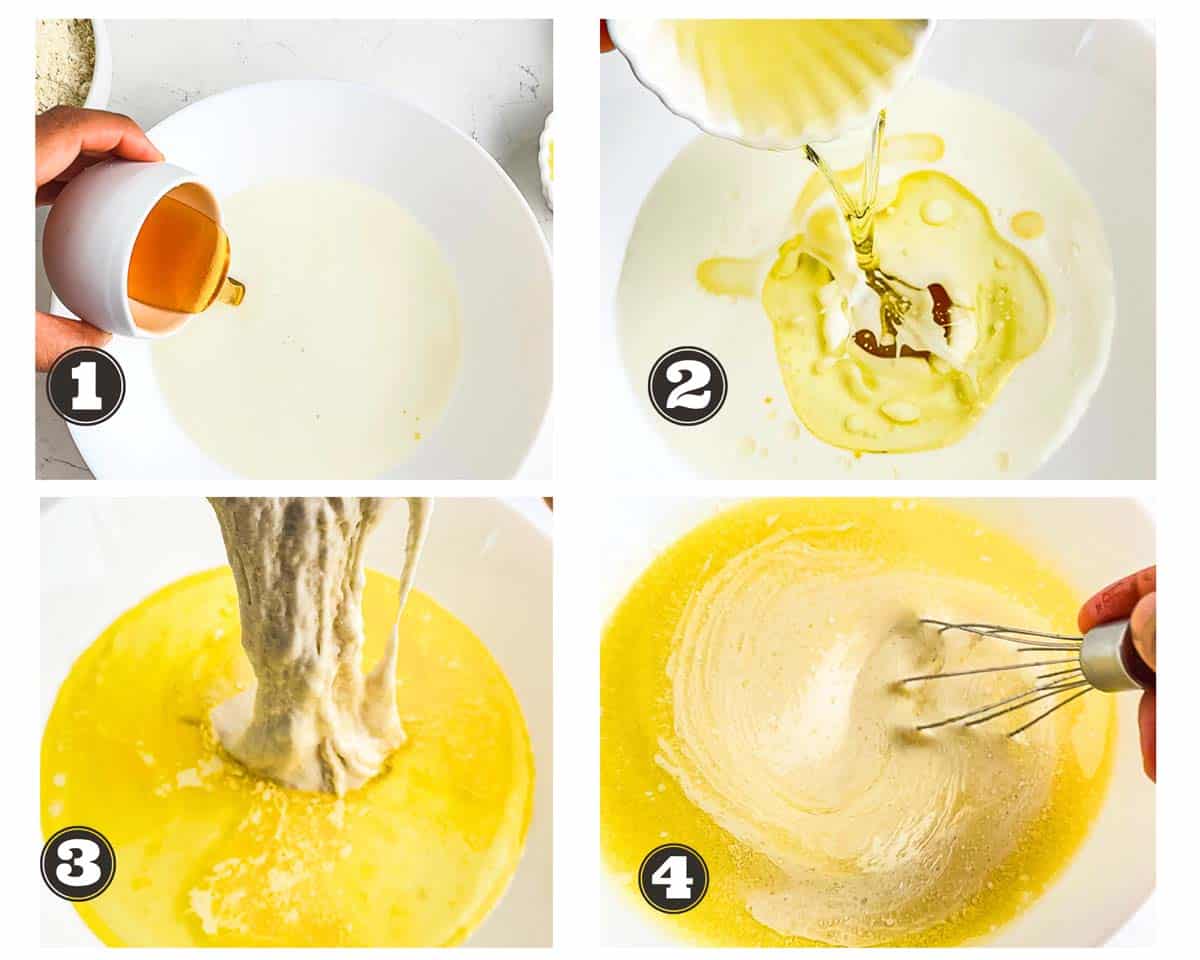
Cover the bowl and let the mixture rest for 20–30 minutes at room temperature. This resting period allows the cornmeal to become tender and prevents a gritty texture in the final bake. This is a key technique in corn flour bread recipes and is especially important for egg-free baking, where texture can make or break the result.
Step 2: Preheat the Oven
While the cornmeal mixture is soaking, preheat your oven to 400°F (200°C). If you’re using a cast iron skillet or iron skillet, place it inside the oven as it preheats. A hot skillet creates a sizzling base that forms a perfectly crisp, golden crust on the bottom and sides of your sourdough cornbread.
Step 3: Mix in the Dry Ingredients
Once the cornmeal has softened, add your dry ingredients to the bowl : all-purpose flour, granulated sugar, salt, and baking powder. Mix well using a whisk.
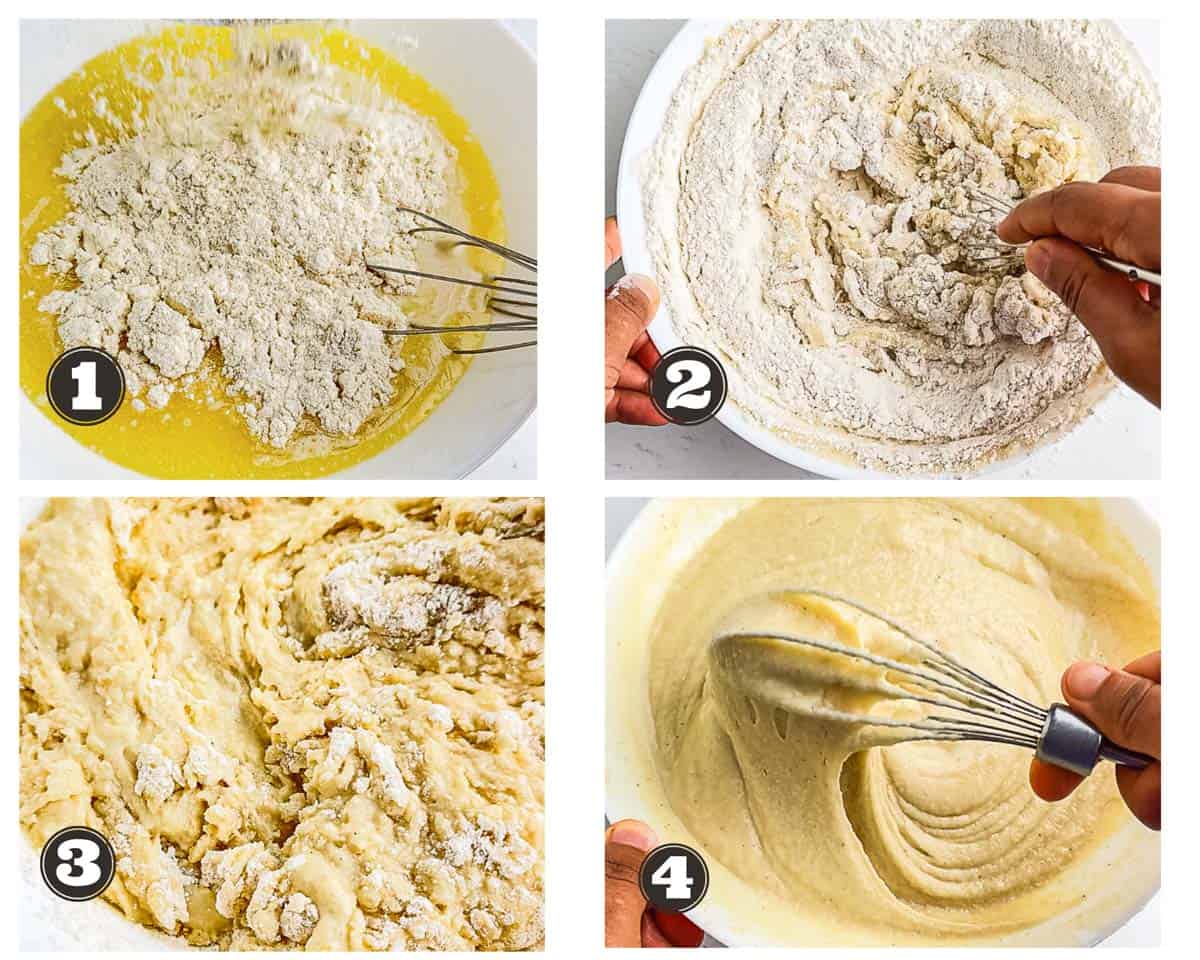
Now, gently fold the dry mix into the wet ingredients using a spatula or wooden spoon. Mix until you no longer see dry patches of flour. The cornbread batter should be thick and scoopable, but not stiff. Avoid overmixing, as it can lead to a dense or gummy texture.
Step 4: Pour into the Pan and Bake
If you’re using a preheated cast iron skillet, carefully remove it from the oven and add 4–5 tablespoons of neutral oil to coat the bottom and sides. Swirl to spread the oil evenly—be careful, it’s hot! You should hear a slight sizzle when the oil hits the pan. Immediately pour the batter into the hot skillet and smooth the top with a spatula.
If using a regular baking pan, line it with parchment paper and grease the sides before adding the batter.
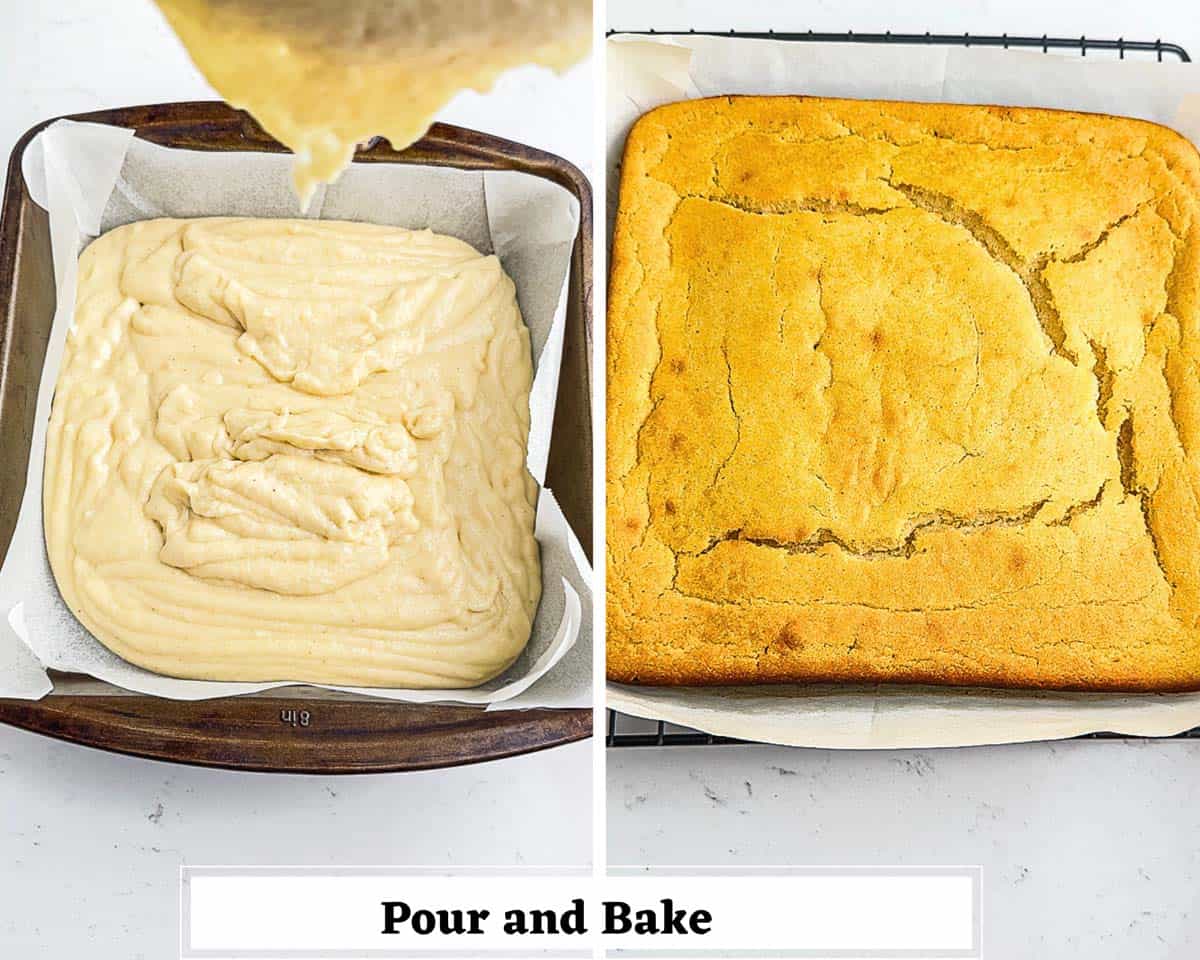
Place the pan in the oven and bake for 22–25 minutes, or until the top is golden brown, the edges have slightly pulled away from the sides, and a toothpick inserted in the center comes out clean. The surface may crack slightly—that’s a good sign of a well-baked, rustic sourdough corn bread.
Step 5: Cool & Serve
Remove the cornbread from the oven and allow it to cool in the pan for at least 10–15 minutes. This helps set the crumb and makes slicing easier. For the best flavor and texture, serve the cornbread warm with a pat of butter and a drizzle of honey.
Other serving ideas include:
- Topped with maple syrup for a sweet brunch
- Pairing with chili or stew
- Turning into cornbread sourdough stuffing for a holiday twist

📝 Recipe Notes & Pro Tips
- Room temperature is key: Make sure your sourdough discard, milk, butter, and even honey are all at room temp. Cold ingredients can cause the batter to seize or bake unevenly.
- Grease your tools: Lightly oil your measuring spoon before handling honey. It’ll glide off easily without sticking.
- Choose the right cornmeal: Medium grind offers the best texture—fine cornmeal can make the batter too soft, while coarse may not tenderize fully even after soaking.
- Sourdough discard vs. starter: Both work! Sourdough discard gives a mild tang and makes the recipe more practical for daily baking. An active sourdough starter may give a slightly more airy rise and deeper flavor.
- Oil matters: Use neutral oil to let the cornmeal flavor shine. Coconut oil works for a slightly sweet, tropical note in vegan sourdough cornbread.
- For muffins: Spoon the batter into lined muffin tins. Bake at 375°F for 15–18 minutes for quick sourdough discard cornbread muffins.
- Add-ins: Try shredded cheese, diced jalapeños, chopped scallions, or corn kernels for added flavor and texture.
- Too dense? You may have overmixed or underbaked. Use fresh baking powder and baking soda, and check oven temperature with a thermometer if needed.
- Dry cornbread? Be sure to measure liquids properly and don’t overbake. The internal temp should be around 195–200°F when done.
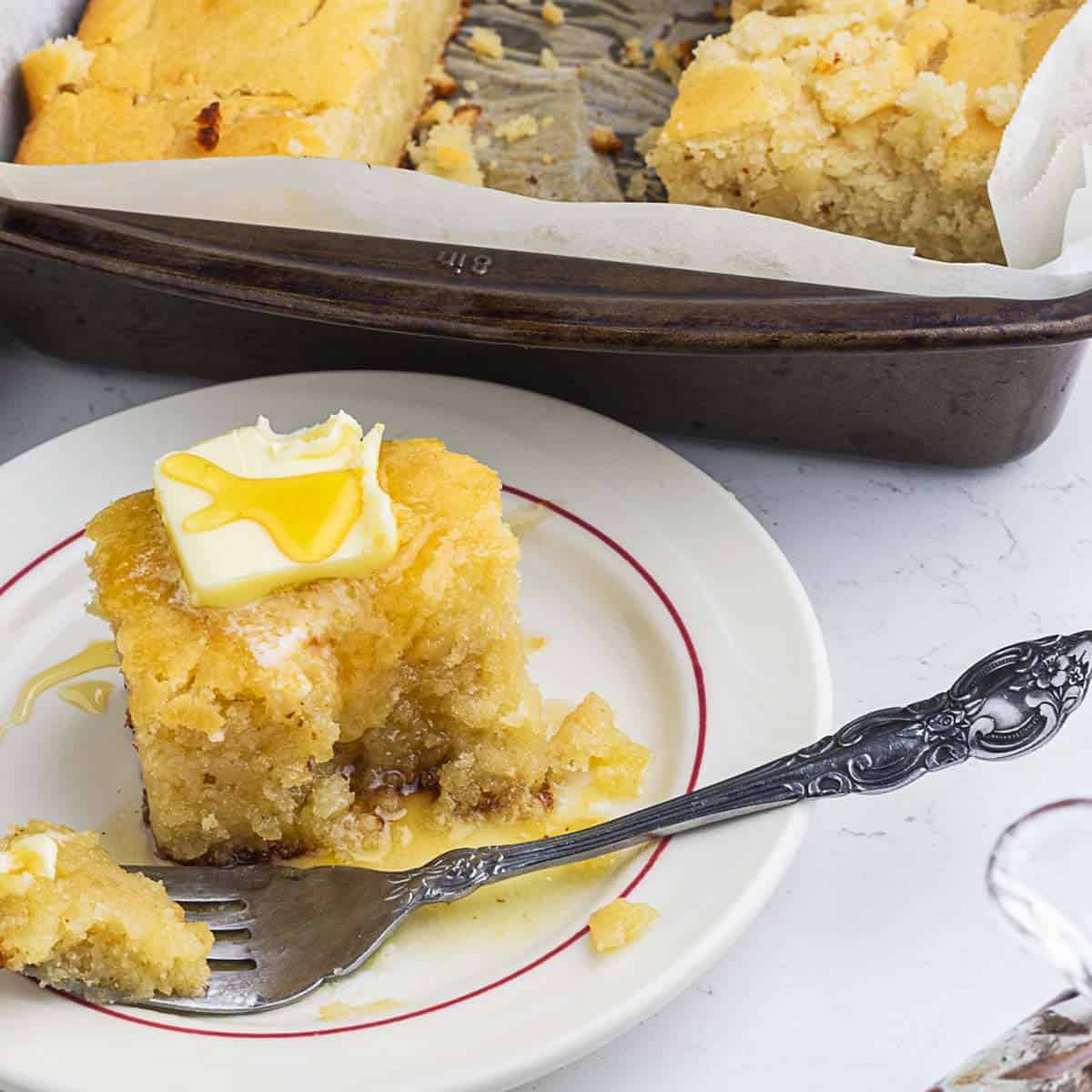
🔗 More Sourdough Discard Recipes
- Sourdough sandwich bread with discard
- Sourdough discard rolls
- Sourdough Discard Focaccia
- Sourdough discard pizza dough
- Sourdough discard Cinnamon Rolls
- Sourdough discard Granola
- Sourdough discard pancakes
- Fried sourdough discard
If you're looking for a cozy, easy way to bake with your sourdough discard, this super-easy and egg-free sourdough cornbread recipe is a total win. Golden, tender, and full of old-fashioned comfort, it’s a recipe you’ll turn to again and again. Don’t forget to leave a comment or tag me if you try this. I'd love to see your pictures of cornbread!
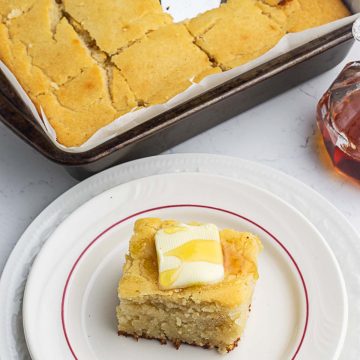
Sourdough Cornbread
Ingredients
Dry Ingredients
- 1 cup cornmeal (121g)
- 1 cup all-purpose flour (128g)
- ½ cup sugar
- 1 teaspoon salt
- 3 ½ teaspoon baking powder
Wet Ingredients
- 1 cup sourdough discard (1-2 day old or active starter)
- 2 cups whole milk room temp. (350g)
- ⅓ cup neutral oil (70g)
- 4 tablespoon unsalted butter (melted (57g))
- 4 tablespoon honey (90g)
Instructions
Mix Wet Ingredients + Soak Cornmeal
- In a large mixing bowl, whisk together the sourdough discard, milk, melted butter, neutral oil, and honey until smooth. Stir in the cornmeal, cover, and let rest for 20–30 minutes to tenderize the grain.
Preheat Oven
- Preheat your oven to 400°F (200°C). If using a cast iron skillet, place it inside to preheat along with the oven.
Add Dry Ingredients
- Once the cornmeal has softened, add your dry ingredients to the bowl:all-purpose flour, granulated sugar, salt, and baking powder. Mix well using a whisk.
- Now, gently fold the dry mix into the wet ingredients using a spatula or wooden spoon. Mix until just combined; do not overmix.
Bake
- Transfer the batter to a parchment lined baking pan.
- If baking in cast iron skillet, carefully remove it from the oven, add 4–5 tablespoons of oil, and swirl to coat. Pour in the batter and smooth the top.
- Bake for 22–25 minutes, or until golden brown and a toothpick comes out clean.
Cool & Serve
- Let cool for at least 10 minutes before slicing. Serve warm with butter and honey, or alongside soup or chili.
Notes
- Room temperature ingredients make for a smoother batter and even baking.
- To measure honey easily, grease your spoon first.
- You can bake this as sourdough cornbread muffins: fill muffin tins and bake at 375°F for 15–18 minutes.
- For extra flavor, stir in corn kernels, cheese, or chopped herbs before baking.
- Storage Tip: Store leftovers in an airtight container at room temp for 1–2 days, or refrigerate for up to 5 days. Reheat slices in a toaster oven or pan to revive the crispy edges!
Nutrition
🫙🔥How to Store & Reheat Sourdough Cornbread
Wondering about the best way to store cornbread? Once cooled, wrap leftovers tightly in foil or place them in an airtight container. Store at room temperature for up to 2 days, or refrigerate for up to 5 days.
To reheat, warm slices in a toaster oven at 300°F for 5–7 minutes, or briefly microwave them (wrapped in a damp paper towel) for soft results. You can also freeze slices for up to 3 months. Just wrap in parchment and foil for best freshness.
❓Frequently Asked Questions
Absolutely! While a cast iron or iron skillet gives this discard cornbread recipe those iconic crispy edges, you can still get great results in a parchment-lined baking dish or even a glass pan. Just preheat the oven and bake as directed. If you want to mimic that crust, preheat your pan in the oven and add a bit of neutral oil before pouring in the batter.
Well, I would not suggest using the refrigerated sourdough starter straight away. We need to bring all ingredients to room temperature. Bringing it to room temperature first ensures a more even bake and better incorporation with other wet ingredients. Cold discard can slightly slow the rise, but since this recipe also uses baking powder and baking soda, it won’t impact the final texture too much. Many recipes for sourdough discard call for room-temperature discard for this reason.


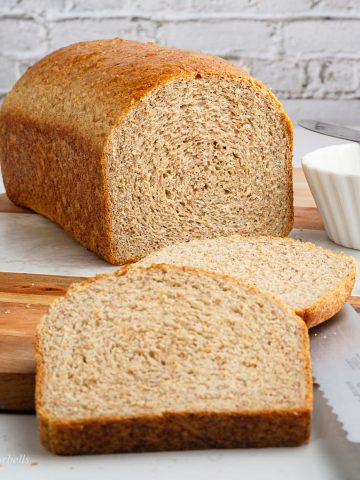
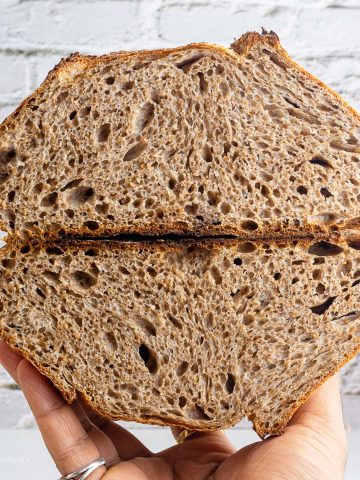


Leave a Reply